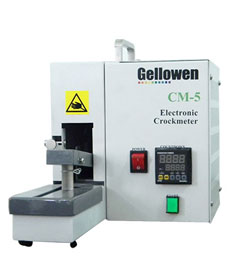
NewsInformation Center
CSI238E Manual Rubbing Color Fastness Tester
2023/02/07
AATCC Dry and Wet Rubbing Color Fastness Tester is a testing instrument for the American Association of Textile Chemists and printing and dyeing workers. The rubbing color fastness tester tests the ability of fabric color transfer from the surface of the material to other materials under dry and wet rubbing. In addition to color transfer testing, the instrument can perform abrasion, wet/dry rubbing, flex, chalking, dry cleaning, grinding and other tests.

1. CSI238E operation method
CSI238E is a manually operated instrument with a reciprocating rotating test head, which is mainly used for testing small printing areas on fabrics. Using standard weights, a friction head with a diameter of 16mm is in contact with the surface of the sample and applies a pressure of 11.1N to it. When the operator turns the handle in the same direction, the friction head first rotates clockwise for 1.125 circles, and then rotates counterclockwise. The specimen is held stationary during the test by applying pressure and installing sandpaper on the base of the apparatus. The upper end of the instrument can be tilted up along the base to facilitate the installation and removal of samples.
2. Optional for CSI238AA and CSI238BB
We offer a full line of interchangeable friction heads and arms to meet the test methods of various industries and organizations. The friction head and friction arm are listed below. If you need the following accessories or other accessories and spare parts of AATCC crocking tester, please contact our customer service department.
3. Replace the friction head
Remove the screw located next to the friction arm above the friction head.
Pull the friction head down from the positioning hole under the friction arm.
Insert the replacement friction head into the positioning hole and fasten it with screws. If the edge of the friction head is flat, its flat side should face the screw.
4. Acrylic rubbing head
The standard rubbing tip for the CSI238AA and CSI238BB is an acrylic rod with a diameter of 16mm (0.63 inches). Larger acrylic rubbing tips provide a 25 mm (1 inch) diameter test surface.
5. Wet specimen rubbing head
Optional hollow nylon friction head for wet and solvent friction tests. Nylon friction tips have the same dimensions as standard friction tips, but have better chemical resistance. It has a loading hole on the side for delivering a fixed amount of liquid evenly to the test cloth through 4 branch holes. When it is filled with a solvent such as MEK, it can be used to evaluate the degree of curing and abrasion of UV-curable inks. The friction head is fastened with screws on the side of the friction arm.
In order to ensure that the rubbing head is correctly fixed on the rubbing arm, first use the standard calibration cloth of the rubbing color fastness tester to test, and check that the generated image is smooth.
6. Friction block
The friction block provides a 19 x 25.4 mm (0.75 x 1 inch) rectangular friction area for testing floor coverings. It is connected to the drive arm by screws on the side of the friction arm. The screws can be 10-32×20mm Allen cylindrical hexagon socket screws, which can be manually fixed and loosened. After the friction block is installed on the driving arm, the rectangular sleeve provided with the friction block can be used to install the test cloth.
7. Yarn test head
Acrylic rubbing tips are optional when testing yarn and linear materials. It is 25mm (2 inches) in diameter and 51mm (2 inches) long. When held in place with a standard rubbing head, a large circular test area is provided to avoid material slipping out. The standard test cloth is held in place by two spring clips equipped with the friction head.
8. Lightweight friction arm
The standard friction arm of CSI238AA and CSI238BB is loaded with a pressure of 9N on the sample. For tests requiring less force, we offer a medium weight (3N) lightweight friction arm. (This type of friction arm has no clamps, and the CSI238AA uses hooks for positioning holes to reduce weight.)
To replace the friction arm, remove the screw securing the drive arm to the crank (note the orientation of the washer) and remove the friction arm assembly from the instrument. Insert the new friction arm assembly into the rail. Insert washers and screws at the specified stroke length to connect the drive arm and crank, and finally tighten the screws.
Previous: 5KN hydraulic universal testing machine maintenance
N e x t : Where can I Find Cardboard boxes Bursting Strength tester?



